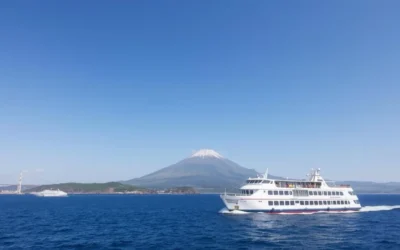✓ Accommodations✓ Flights✓ Rental Cars
Welcome to Gifu City, a hidden gem in the heart of Japan that offers a perfect blend of rich history, natural beauty, and cultural experiences.
You’ll discover why this centrally located city deserves a spot on your Japan itinerary, from its iconic castle perched atop Mount Kinka to its ancient fishing traditions.
This comprehensive guide will walk you through the top attractions, seasonal highlights, and local experiences that make Gifu City special.
Discovering the Heart of Japan: Gifu City at a Glance
As you step into Gifu City, you’ll discover a fascinating blend of Japan’s rich history and vibrant culture. This city is not just a stop on your journey; it’s a destination that offers a unique experience, blending the old with the new.
Where is Gifu City Located?
Gifu City is situated in the heart of Japan’s Chubu region, making it an ideal base for exploring central Japan. You’ll find that the city serves as the capital of Gifu Prefecture and is strategically located between Tokyo and Kyoto, approximately 30 minutes from Nagoya by train. The city’s unique position at the confluence of the Nagara River, surrounded by mountains, creates a picturesque setting that blends urban convenience with natural beauty.
Why Gifu City Should Be on Your Japan Itinerary
Gifu City played a pivotal role in Japanese history, particularly during the Sengoku period, making it a fascinating destination for history enthusiasts. You’ll discover that Gifu offers authentic cultural experiences without the overwhelming crowds found in Japan’s larger tourist destinations. The area serves as an excellent gateway to other attractions in central Japan, including the UNESCO World Heritage site of Shirakawa-go. Gifu perfectly balances traditional Japanese heritage with modern amenities, creating a comfortable yet culturally rich travel experience.
The city’s historical significance, coupled with its natural beauty and modern conveniences, makes it an ideal destination for travelers. You’ll appreciate the city’s ability to blend tradition with modernity, offering a unique and enriching experience.
The Historical Significance of Gifu City
Gifu City, a place steeped in history, played a pivotal role in shaping Japan’s past. As you walk through its streets, you’re walking through living history, where every landmark and tradition tells a story of the city’s crucial role in Japan’s unification during the Sengoku period.
Gifu’s Role in Japanese Unification
Gifu City’s strategic location made it a pivotal battleground and political center as powerful warlords fought to control the country. You’ll discover how the city’s position facilitated its role in the unification process, serving as a base for operations for influential leaders. The city’s rich history is a testament to its significance, with preserved historical sites, museums, and cultural traditions that continue to honor this period.
The name “Gifu” itself is steeped in historical significance, chosen by Oda Nobunaga to symbolize his ambition to unify Japan, drawing inspiration from ancient Chinese history. This act reflects the city’s importance in Nobunaga’s plans to bring the warring states under one rule.
Oda Nobunaga’s Legacy in Gifu
Oda Nobunaga, one of Japan’s most famous historical figures, captured Inabayama Castle in 1567 and renamed it Gifu Castle, along with the surrounding town. You’ll learn how Gifu served as Nobunaga’s base of operations, launching campaigns that would eventually shape modern Japan. His innovations in military tactics, governance, and economic policies that began in Gifu had a lasting impact on the country.
Gaining insight into Nobunaga’s time in Gifu provides a deeper understanding of how his legacy continues to influence the city and Japan as a whole. The city’s historical sites and cultural practices are a living testament to Nobunaga’s influence, making Gifu a unique destination for history enthusiasts.
Gifu Castle: The Iconic Fortress Atop Mount Kinka
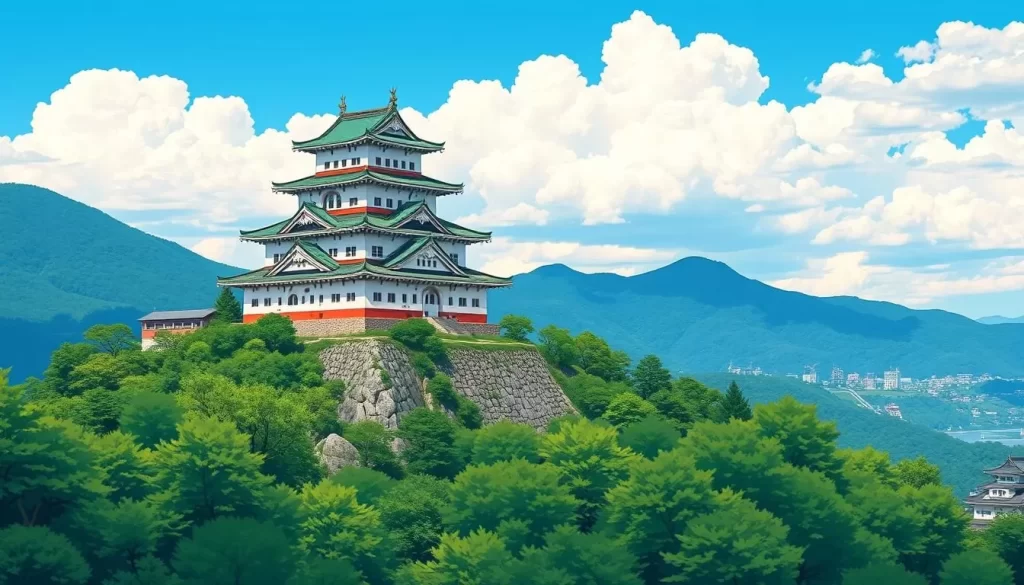
Standing proudly on Mount Kinka, Gifu Castle is a testament to Japan’s rich history and culture. You’ll be awestruck by Gifu Castle, perched atop Mount Kinka at a height of 329 meters, offering one of the most impressive panoramic views of any castle in Japan.
History and Significance of Gifu Castle
The castle has a fascinating history dating back to the 16th century, though the current structure is a concrete reconstruction completed in the 1950s after the original was destroyed. It played a crucial role in Japan’s unification and is a symbol of Gifu City’s rich heritage.
How to Reach the Castle: Hiking vs. Ropeway
You have two options to reach Gifu Castle: take the scenic Mount Kinka Ropeway for a quick 4-minute ride, or challenge yourself with the hiking trail that takes about an hour but rewards you with beautiful natural scenery. The ropeway offers a convenient and scenic route, while the hiking trail provides an opportunity to enjoy the surrounding nature.
What to See Inside the Castle Museum
Inside the castle museum, you’ll discover exhibits featuring samurai armor, weapons, and historical artifacts that tell the story of the castle’s strategic importance. The castle’s observation deck provides breathtaking 360-degree views of Gifu City, the winding Nagara River, and on clear days, you can see as far as Nagoya.
You should plan to spend about 1-2 hours exploring both the castle and its surroundings, with opening hours typically from 9:30 AM to 4:30 PM (last admission at 4:00 PM). The castle is particularly beautiful during cherry blossom season in spring and the autumn foliage season, when the mountain’s natural beauty enhances the historical atmosphere.
Experience Ukai: The Ancient Art of Cormorant Fishing

The Nagara River in Gifu City is home to the captivating Ukai, or cormorant fishing, a tradition spanning over 1,300 years. This ancient technique involves skilled fishermen known as “Usho” who use trained cormorant birds to catch ayu, or sweetfish, creating a mesmerizing spectacle, especially when illuminated by traditional flames at night.
The 1,300-Year Tradition of Cormorant Fishing
Ukai is not just a fishing method; it’s a living piece of history that has been practiced on the Nagara River for centuries. The tradition is deeply connected to Japanese imperial history, having been performed exclusively for the Emperor and high-ranking officials. This cultural significance is still palpable today as you watch the skilled fishermen at work.
Best Times to Watch Ukai on the Nagara River
The fishing season typically runs from May 11th to October 15th, with performances taking place every night except during heavy rain or when the river is too high. Spring is a particularly beautiful time as the fishing season begins, and the combination of cherry blossoms along the riverbanks and the traditional fishing boats creates a uniquely Japanese scene that photographers will love.
Booking a Boat Tour for the Ultimate Experience
To fully experience Ukai, booking a boat tour is highly recommended. You’ll have the best experience by floating alongside the fishing boats, giving you an up-close view of this remarkable tradition. There are various boat options available, from large sightseeing vessels to more intimate private boats, some of which serve dinner while you watch the fishing demonstration.
By experiencing Ukai, you’re not just watching a spectacle; you’re participating in a centuries-old tradition that is both a testament to Japan’s rich cultural heritage and a thrilling display of skill and nature.
Mount Kinka: Natural Beauty in the Heart of the City
As you explore Gifu City, you’ll discover Mount Kinka, a breathtaking natural landmark that rises dramatically above the cityscape. This mountain is not just a visual treat but also a hub for outdoor activities and nature appreciation.
Hiking Trails and Scenic Viewpoints
Mount Kinka offers several well-maintained hiking trails that cater to different fitness levels, allowing you to walk through diverse landscapes and enjoy scenic viewpoints. As you hike, you’ll encounter a variety of flora and fauna, including small shrines that add a cultural touch to your journey. The trails are designed to provide an immersive experience in nature, making it a perfect spot for nature lovers.
The Mount Kinka Ropeway Experience
For those preferring a more leisurely experience, the Mount Kinka Ropeway offers a quick and spectacular ride to near the summit. From the ropeway’s upper station, it’s a short walk to Gifu Castle, perched atop Mount Kinka, and various observation points that showcase the city’s natural beauty. The ropeway ride itself is an experience, offering panoramic views of Gifu City and the surrounding landscape.
| Activity | Difficulty Level | Duration |
|---|---|---|
| Hiking | Moderate to Challenging | 2-4 hours |
| Ropeway Ride | Easy | 5 minutes |
Mount Kinka is a year-round destination, with each season offering a unique experience. From the cherry blossoms of spring to the vibrant autumn colors, the mountain transforms, providing a different landscape with each visit. Whether you’re interested in hiking, nature, or simply enjoying the views, Mount Kinka is a must-visit when in Gifu City.
Spiritual Gifu: Temples and Shrines Worth Visiting
As you wander through Gifu, you’ll discover a rich tapestry of temples and shrines, each with its own unique history and significance. The city’s spiritual landscape is a testament to its rich cultural heritage, offering visitors a chance to explore the depths of Japanese spirituality.
Shōhō-ji Temple and the Great Buddha of Gifu
One of Gifu’s most notable spiritual sites is Shōhō-ji Temple, famous for housing the Great Buddha of Gifu, or Gifu Daibutsu. This impressive statue stands over 13 meters tall and is crafted from bamboo and Japanese paper, making it one of Japan’s largest indoor Buddha statues. The temple grounds are a serene escape, with beautiful gardens and historical structures dating back to the Edo period, inviting you to walk among the tranquility.
Inaba Shrine: A Peaceful Sanctuary
Inaba Shrine is another significant spiritual site in Gifu, providing a peaceful sanctuary in the heart of the city. This shrine is notable for its elegant architecture and historical connection to Oda Nobunaga, who prayed here before capturing Gifu Castle. Visitors can appreciate the shrine’s serene atmosphere and historical significance, making it a worthwhile visit.
Other Notable Religious Sites in Gifu
Gifu is home to many other religious sites worth visiting, with several located around Mount Kinka and Gifu Park, making it convenient to explore multiple sites in a single day. The variety of temples and shrines showcases different architectural styles and religious traditions, offering insights into Japan’s complex spiritual history. Many of these sites host seasonal festivals and events, providing unique cultural experiences.
| Temple/Shrine | Notable Feature | Location |
|---|---|---|
| Shōhō-ji Temple | Great Buddha of Gifu | Gifu City Center |
| Inaba Shrine | Elegant Architecture | Near Gifu Park |
| Various Temples and Shrines | Seasonal Festivals | Around Mount Kinka |
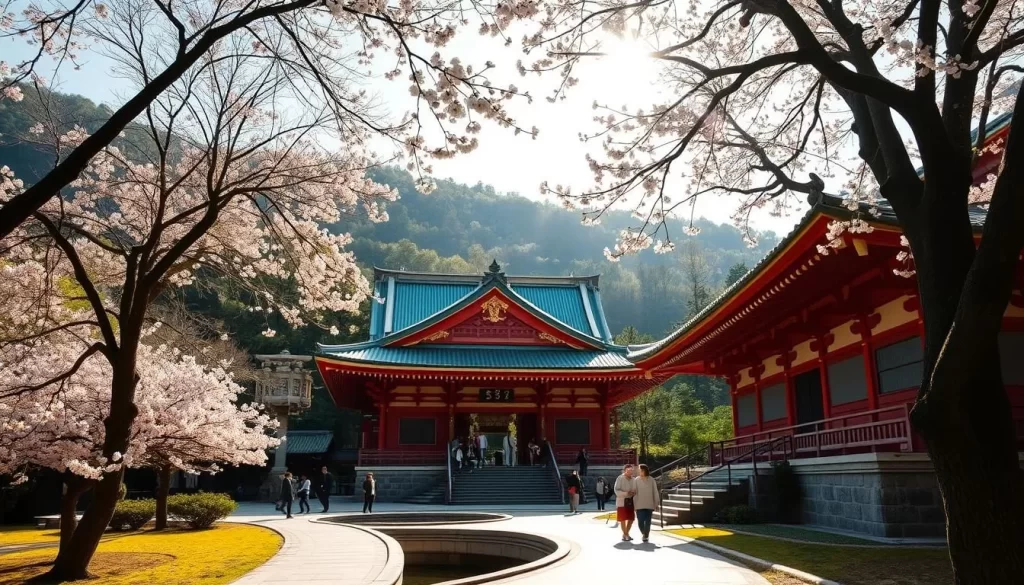
Gifu City, Japan: Best Things to Do for Culture Lovers
Immerse yourself in the cultural richness of Gifu City, where history and tradition come alive. As a culture lover, you’ll find numerous opportunities to engage with the city’s heritage through various workshops, museums, and cultural centers.
Traditional Craft Workshops: Paper Umbrellas and Lanterns
Gifu City offers a unique chance to experience traditional Japanese craftsmanship firsthand. At various workshops, you can participate in creating traditional paper umbrellas and lanterns, crafts that have been perfected over hundreds of years. Many shops in the city provide hands-on experiences where, under the guidance of skilled artisans, you can try making your own traditional crafts. This not only allows you to appreciate the skill involved but also to create a meaningful souvenir of your visit to Gifu City.
- Engage in the art of making traditional paper umbrellas.
- Create your own lanterns with expert guidance.
- Explore various shops offering these unique experiences.
Museums and Cultural Centers in Gifu
The city is home to several museums and cultural centers that showcase its rich history and cultural heritage. The Gifu City Museum of History is particularly noteworthy, as it delves into the region’s past, with a special emphasis on the Sengoku period and Oda Nobunaga’s significant influence on the area. Additionally, the Nagara River Traditional Industries Museum offers fascinating exhibits on the crafts and industries that have sustained Gifu City for years.
| Museum/Cultural Center | Focus | Highlights |
|---|---|---|
| Gifu City Museum of History | Regional history, Sengoku period | Oda Nobunaga’s legacy, historical artifacts |
| Nagara River Traditional Industries Museum | Traditional crafts and industries | Exhibits on local crafts, historical significance |
| Various Art Galleries | Traditional and contemporary art | Works by local artists, cultural exhibitions |
These sites not only provide insight into Gifu’s past but also offer a glimpse into its vibrant cultural present, making Gifu City a compelling destination for culture enthusiasts.
Seasonal Beauty: Cherry Blossoms and Autumn Leaves in Gifu
As the seasons change, Gifu City reveals its diverse beauty, from vibrant cherry blossoms to stunning autumn foliage. You’ll find that each season brings its own unique charm to this Japanese city, making it a great destination to visit at any time of the year.
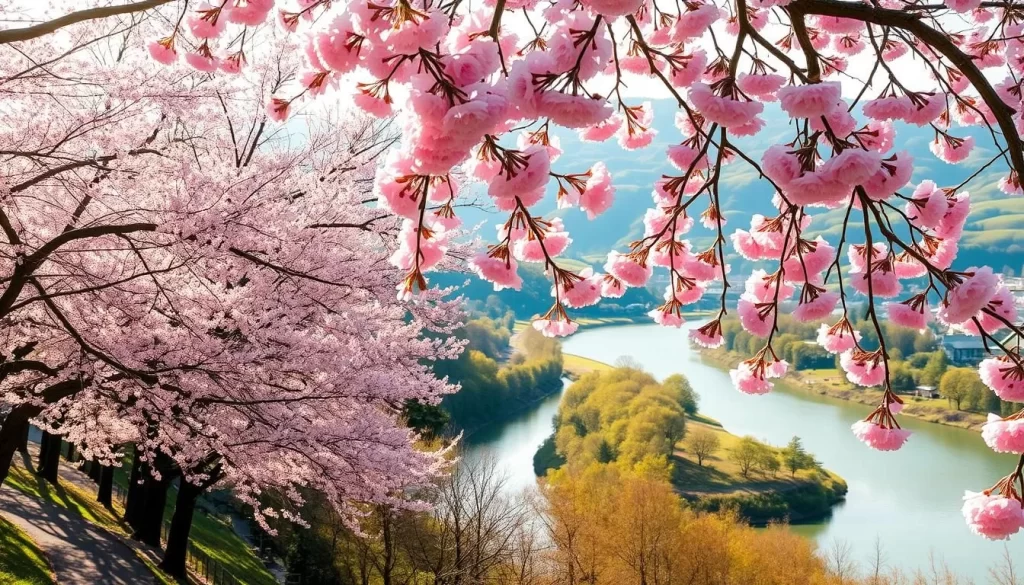
Top Cherry Blossom Viewing Spots
Gifu City is renowned for its spectacular cherry blossom season, which typically occurs from late March to early April. During this time, thousands of cherry trees burst into delicate pink and white blooms, creating a breathtaking landscape.
- The banks of the Nagara River are a popular spot for cherry blossom viewing, offering beautiful reflections of the blossoms in the water.
- Gifu Park is another prime location for hanami (cherry blossom viewing), with hundreds of cherry trees creating a canopy of blossoms and plenty of space for traditional picnics under the trees.
Autumn Foliage: When and Where to Experience It
In autumn, usually from mid-November to early December, Gifu’s landscape transforms again as maple and ginkgo trees display vibrant red, orange, and golden foliage. Mount Kinka becomes a canvas of autumn colors, with the hiking trails offering spectacular views of the seasonal transformation against the backdrop of Gifu Castle.
- The changing season influences local cuisine as well, with special seasonal dishes and ingredients appearing in restaurants throughout the cherry blossom and autumn foliage seasons.
- Local festivals often coincide with these peak seasonal periods, adding cultural experiences to the natural beauty and creating perfect photo opportunities.
Culinary Delights: Savoring Gifu’s Local Cuisine
When visiting Gifu, you’ll discover a world of flavors that blend traditional Japanese cuisine with local specialties. The city’s culinary identity is shaped by its rich history, geographical location, and cultural heritage, making it a must-visit destination for food enthusiasts.
Hida Beef: Gifu’s Premium Wagyu Experience
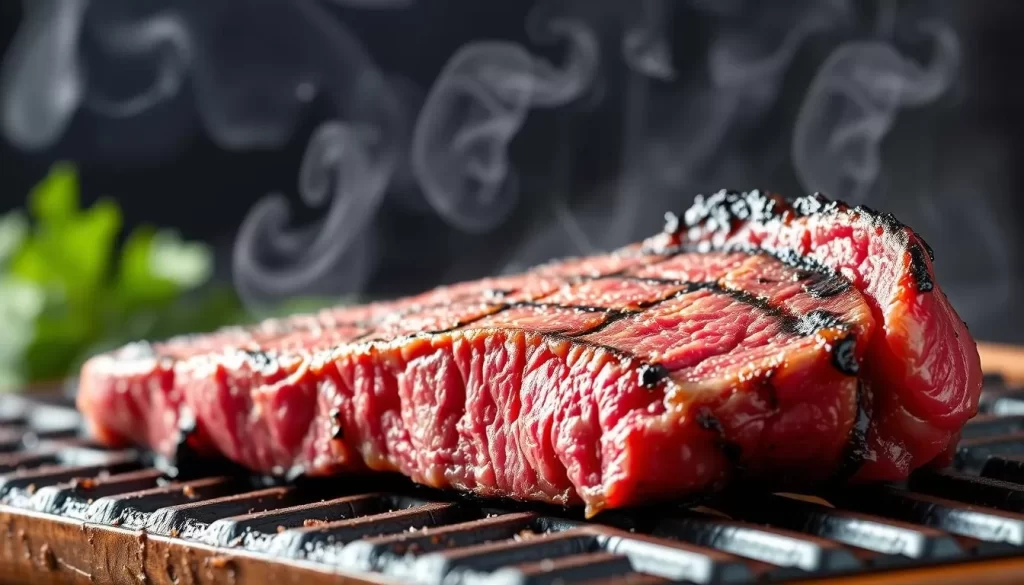
Gifu is famous for its Hida beef, a prestigious variety of Wagyu known for its exceptional marbling, tenderness, and rich flavor. You’ll find many restaurants in Gifu specializing in Hida beef, serving it in various styles, from traditional sukiyaki and shabu-shabu to grilled steaks and even as casual street food skewers.
River Fish Specialties and Ayu
The Nagara River provides Gifu with an abundance of fresh ayu (sweetfish), a local delicacy often grilled with salt on skewers. This sweet and refreshing dish is especially prized during the summer months, offering a unique taste of Gifu’s riverine bounty.
Street Food and Local Delicacies to Try
Gifu’s street food scene is not to be missed, with offerings like mitarashi dango (sweet rice dumplings with soy glaze) and various seasonal treats. You’ll also discover unique local dishes such as keichan (chicken and cabbage stir-fry) and Takayama ramen, featuring thin noodles in a light soy-based broth. Many restaurants pride themselves on using locally-sourced, seasonal ingredients, reflecting Gifu’s agricultural heritage and connection to its natural surroundings.
For the full culinary experience, consider dining at a traditional ryokan or specialty restaurant where Hida beef is prepared tableside, allowing you to appreciate the craftsmanship that goes into preparing this premium ingredient.
Festivals and Events: Experiencing Gifu’s Vibrant Traditions
Experience the essence of Gifu’s traditions through its numerous festivals and events that take place throughout the year. Gifu City is known for its rich cultural heritage, and its festivals are a testament to its vibrant history and cultural identity.
The Gifu Lantern Festival
The Gifu Lantern Festival is a mesmerizing spectacle held annually in October. Thousands of handcrafted paper lanterns illuminate the historic streets, creating a magical atmosphere that honors the city’s traditional craftsmanship. The festival transforms ordinary sites into extraordinary displays of light and shadow, with lanterns of various shapes and sizes lining streets, floating on water, and adorning historic buildings.
Gifu Nobunaga Festival
The Gifu Nobunaga Festival celebrates the legacy of the famous warlord Oda Nobunaga with historical reenactments, traditional performances, and a grand parade featuring participants in period costumes. Typically held in early summer, this festival is a significant event that draws visitors from across the country.
Other Seasonal Celebrations
Gifu City hosts various seasonal celebrations throughout the year. During summer, you can experience the Nagaragawa Fireworks Festival, one of Japan’s largest fireworks displays, where over 30,000 fireworks light up the night sky above the river. Many of these festivals have been celebrated for hundreds of years, connecting modern visitors to traditions that have shaped the cultural identity of Gifu.
| Festival/Event | Time of Year | Description |
|---|---|---|
| Gifu Lantern Festival | October | Thousands of handcrafted lanterns illuminate historic streets |
| Gifu Nobunaga Festival | Early Summer | Celebrates Oda Nobunaga’s legacy with historical reenactments and parades |
| Nagaragawa Fireworks Festival | Summer | One of Japan’s largest fireworks displays with over 30,000 fireworks |
Day Trips from Gifu City: Exploring the Surrounding Region
With its central location, Gifu City allows you to easily discover the cultural and historical gems of the surrounding area. The region is dotted with world heritage sites, historical landmarks, and natural beauty, making it an ideal base for various day trip options.
Shirakawa-go: UNESCO World Heritage Village
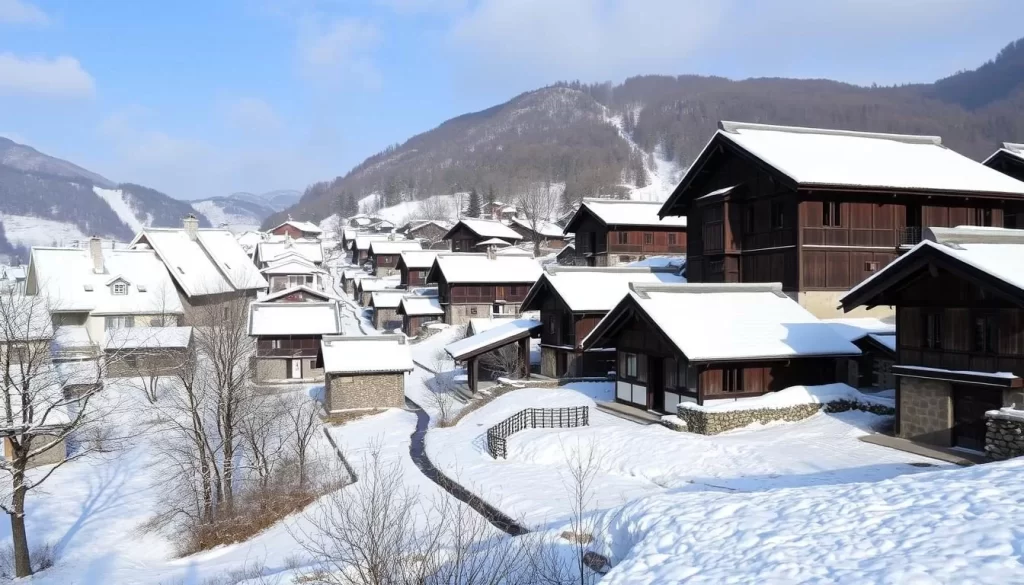
You’ll be transported back in time with a day trip to Shirakawa-go, a world heritage site famous for its traditional gassho-zukuri farmhouses. This picturesque village is particularly magical in winter when illuminated against a snowy backdrop, though it’s beautiful year-round and accessible by bus from Gifu City.
Takayama: The Little Kyoto of Hida
Takayama, often called “Little Kyoto of Hida,” charms visitors with its beautifully preserved old town, morning markets, and traditional sake breweries, all reachable by a scenic train ride through the mountains.
Sekigahara: Battlefield of Japanese Unification
History enthusiasts will appreciate Sekigahara, the site of the decisive 1600 battle that led to the unification of the country under the Tokugawa shogunate, featuring a museum and marked battlefield areas related to Japanese history.
The surrounding area of Gifu Prefecture offers diverse experiences, from the pottery town of Tajimi where you can shop for ceramics or try making your own, to the relaxing hot springs of Gero Onsen, accessible by train. These day trips showcase the rich cultural and historical tapestry of the region, allowing you to experience different aspects of traditional Japan while based in Gifu City.
Family-Friendly Activities in Gifu City
Gifu City is a haven for families, offering a variety of activities that cater to all ages. The city seamlessly blends traditional Japanese culture with modern entertainment, ensuring that there’s something for everyone.
Gifu World Fresh Water Aquarium Aquatotto
The Gifu World Fresh Water Aquarium Aquatotto is a fascinating destination for families. It showcases diverse aquatic life from the Nagara River and freshwater habitats around the world. The aquarium’s interactive exhibits and touch pools allow children to engage with marine life in a hands-on way, making learning about nature fun and memorable. You can explore the various aquatic ecosystems and get up close with the creatures that inhabit them.
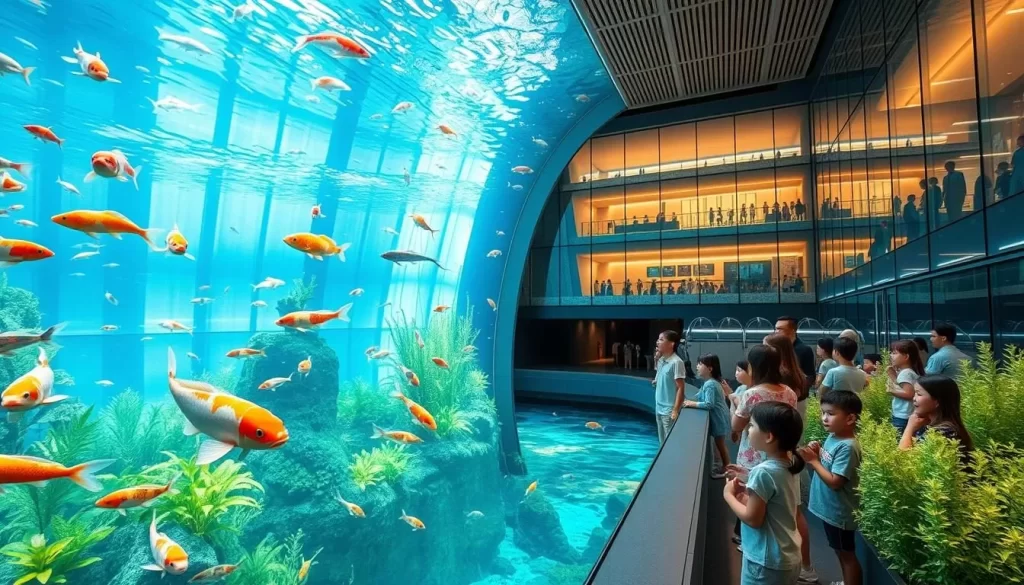
Parks and Recreational Areas for Children
Gifu Park offers expansive green spaces perfect for children to run and play, with playground equipment, open fields, and beautiful landscapes that nature lovers of all ages will appreciate. In spring, the park becomes especially popular with families enjoying picnics under the cherry blossoms, creating picture-perfect moments and lasting memories. You can also take a leisurely walk along the Nagara River promenade, which features child-friendly paths, rest areas, and opportunities to observe river wildlife and boats.
| Location | Activity | Best Time to Visit |
|---|---|---|
| Gifu World Fresh Water Aquarium Aquatotto | Explore aquatic life and interactive exhibits | Anytime |
| Gifu Park | Picnics, playgrounds, and cherry blossom viewing | Spring |
| Nagara River Promenade | Leisurely walks and observing river wildlife | Anytime |
Practical Travel Tips: Navigating Gifu with Ease
As you prepare for your adventure in Gifu City, understanding the practical travel tips will enhance your overall experience. Gifu City is a treasure trove of historical and cultural experiences, and being well-prepared will allow you to make the most of your trip.
Getting to and Around Gifu City
Gifu City is easily accessible by train, with the journey from Nagoya Station taking approximately 20 minutes on the JR Tokaido Main Line or the Meitetsu Line. For those traveling on the Shinkansen, Gifu-Hashima Station is on the Tokaido Shinkansen line, with connecting trains to Gifu Station taking about 15 minutes. Within the city, you can navigate efficiently using the local bus network, with many key attractions located within walking distance of each other in the central area.
| Transportation Method | Travel Time | Frequency |
|---|---|---|
| JR Tokaido Main Line/Meitetsu Line from Nagoya | Approximately 20 minutes | Frequent |
| Shinkansen to Gifu-Hashima + Connecting Train | About 15 minutes (connecting train) | Regular |
| Local Bus within Gifu City | Varies | Frequent |
Best Times to Visit: Weather and Seasonal Considerations
The best times to visit Gifu City are during spring (March-May) for cherry blossoms and pleasant temperatures, and autumn (October-November) for colorful foliage. Each season offers unique experiences, though summer can be hot and humid, and winter is relatively mild compared to northern Japan.
- Spring: Cherry blossoms and mild weather
- Autumn: Colorful foliage
- Summer: Hot and humid
- Winter: Mild with potentially reduced attraction hours
Accommodation Options in Gifu
Gifu City offers a range of accommodation options, from traditional ryokans to modern hotels near Gifu Station. Prices are generally more reasonable than in major tourist cities, making it an affordable destination. For a convenient trip, consider purchasing a one-day bus pass or renting a bicycle to explore the compact city center.
Planning Your Perfect Gifu Itinerary: From One Day to One Week
Whether you’re in Gifu for a day or a week, having a well-structured itinerary can enhance your travel experience. Gifu City offers a mix of historical landmarks, cultural experiences, and natural beauty, making it a versatile destination for various interests.
One-Day Highlights Tour of Gifu
For a one-day visit, start with a morning visit to Gifu Castle for panoramic views of the city. Follow this with lunch at a local restaurant serving specialties like Hida beef. Spend your afternoon exploring cultural sites such as Shōhō-ji Temple and Inaba Shrine. End your day with an evening cormorant fishing experience on the Nagara River.
Three-Day Comprehensive Gifu Experience
With three days, you can explore Gifu at a more relaxed pace. Visit museums, temples, and workshops to delve deeper into the city’s culture. Take time to enjoy local cuisine and appreciate the city’s atmosphere. This duration allows you to visit major attractions without feeling rushed, giving you a more comprehensive experience of Gifu City.
One-Week Itinerary: Gifu and Surrounding Areas
A one-week stay enables you to use Gifu as a base for exploring the wider region. Take day trips to nearby attractions like Shirakawa-go, a UNESCO World Heritage site, and Takayama, known for its traditional architecture. With ample time, you can thoroughly experience both Gifu City and its surroundings.
| Duration | Highlights | Activities |
|---|---|---|
| 1 Day | Gifu Castle, Local Cuisine, Cultural Sites | Morning castle visit, lunch, afternoon cultural exploration, evening cormorant fishing |
| 3 Days | Museums, Temples, Workshops, Local Atmosphere | Relaxed exploration of cultural and historical sites, enjoying local food |
| 1 Week | Gifu City, Shirakawa-go, Takayama | Day trips to nearby attractions, thorough exploration of Gifu City |
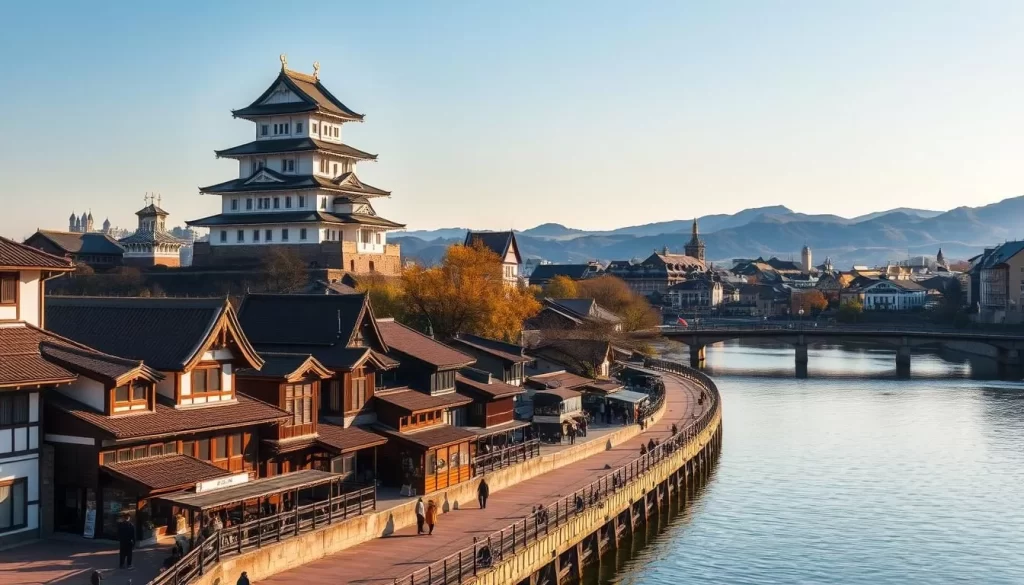
Conclusion: Why Gifu City Deserves a Spot on Your Japan Bucket List
As you conclude your journey through Gifu City, it’s clear that this hidden gem offers an unforgettable blend of Japan’s rich history and breathtaking nature. You’ve discovered that Gifu City offers a perfect balance of Japan’s rich history and natural beauty, from the legacy of Oda Nobunaga to the scenic Nagara River that winds through the heart of the city.
The unique experiences you can only find here—like watching master fishermen practice the 1,300-year-old tradition of cormorant fishing or savoring authentic Hida beef in its home prefecture—make Gifu truly special. The city’s rich history is palpable, from the iconic Gifu Castle perched atop Mount Kinka to the numerous temples and shrines that dot the landscape.
Gifu City serves as an ideal base for exploring central Japan, with convenient train connections to world heritage sites and charming traditional villages. The seasonal beauty of Gifu, from spring cherry blossoms to autumn foliage, creates picture-perfect backdrops for your Japanese adventure throughout the year.
Whether you’re a history buff, nature lover, foodie, or cultural explorer, Gifu City offers rich experiences that will make your trip to Japan more diverse, authentic, and memorable. With its relaxing hot spring options, delicious local cuisine, and authentic atmosphere, Gifu City is a destination that will leave you enchanted and eager for more.
The above is subject to change.
Check back often to TRAVEL.COM for the latest travel tips and deals.

